Ocean Newsletter
No.532 October 5, 2022
-
Assessing the Current State of Acidification in Japan's Coastal Areas and Adaptation Measures
ONO Tsuneo (Chief Scientist, Fisheries Resources Institute, Japan Fisheries Research and Education Agency)
Ocean acidification is one of the problems of global warming. In order to investigate the state of ocean acidification in Japan’s coastal areas and its impacts on coastal organisms, the Ocean Acidification Adaptation Project was launched in 2020 on a grant from The Nippon Foundation. The two-year study has already begun to provide insight into the causes and effects of acidification, and it’s becoming clear that technology used for improving coastal water quality is useful for limiting acidification. We are anticipating effective measures for adapting to acidification in Japan’s coastal regions.
-
Kobe University’s New Training Ship the Kaijin Maru
KATSUI Tokihiro (Professor, Kobe Ocean-Bottom Exploration Center, Kobe University)
The handover ceremony for Kobe University's new training ship, the Kaijin Maru, was held on March 23, 2022. The ship has now embarked on its vital mission of fostering maritime human resources. The Kaijin Maru is a next-generation, high-performance training ship, equipped with various functions. This article describes its features and functions.
-
Towards the Conservation, Nurturing, and Sustainable Use of Precious Corals
KUMON Fujio (Visiting Professor, Center for Advanced Marine Core Research, Kochi University) ,MEZAKI Takuma (Director, Kuroshio Biological Research Foundation)
The recent economic boom has led to increased harvesting of precious corals, creating concern that stocks of this slow-growing species may become depleted. Along with regulating harvested amounts, efforts are being made to artificially propagate precious corals (aquaculture) by embedding live branch tips in a concrete disk substrate for their release and cultivation. Due to the ecological characteristics of these corals, their sustainable utilization requires a long-term commitment spanning decades.
Towards the Conservation, Nurturing, and Sustainable Use of Precious Corals
[KEYWORDS] red corals / growth substrate / aquacultureKUMON Fujio
Visiting Professor, Center for Advanced Marine Core Research, Kochi University
MEZAKI Takuma
Director, Kuroshio Biological Research Foundation
The recent economic boom has led to increased harvesting of precious corals, creating concern that stocks of this slow-growing species may become depleted. Along with regulating harvested amounts, efforts are being made to artificially propagate precious corals (aquaculture) by embedding live branch tips in a concrete disk substrate for their release and cultivation. Due to the ecological characteristics of these corals, their sustainable utilization requires a long-term commitment spanning decades.
What Are Precious Corals?
Precious corals have long been used as jewelry and accessories, with the oldest examples dating back 20,000 years. Their application is thought to have originated in the Mediterranean region, and red corals (Corallium japonicum Kishinouye, 1903) from this area have been widely used. Even the Shosoin Treasures include precious coral ornaments that were brought via the Silk Road.
Commercial harvesting of precious corals in Japan only began in the Meiji period (1868-1912) after being banned during the Edo period (1603-1868). The method of harvesting these corals from the seafloor with nets began and spread from present-day Muroto City in Kochi Prefecture. Japan became a major producer to compensate for the depletion of Mediterranean red corals at the time. At one point in the early Meiji period, exports of these corals brought in the largest amounts of foreign currency out of all exported goods. Italian brokers based in Kobe were reportedly purchasing this coral for resale in various places around Kochi Prefecture.
Precious corals are in a different group from reef-building corals, which grow and create coral reefs in shallow waters; they instead grow in deeper waters between 100 m and 600 m in depth. They form a dense skeletal axis that, when polished, produce lustrous jewelry (Figure 1). Red, peach, and white-colored corals are the primary species caught in Japan.
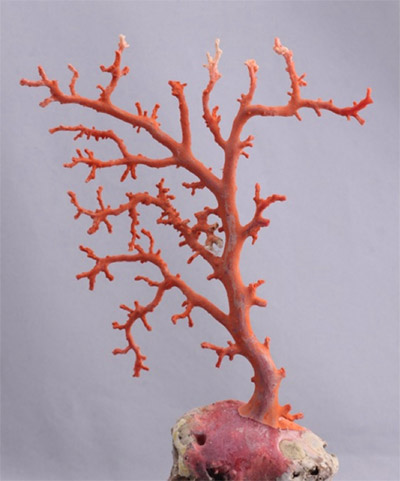
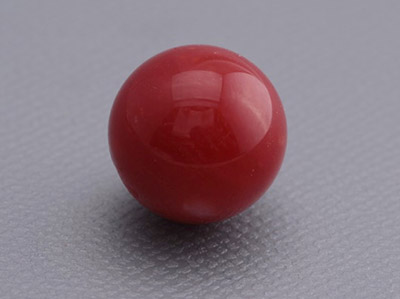 ■ Figure 1: A red coral colony and skeletal axis polished into a ball (courtesy of the Japanese Coral Association).
■ Figure 1: A red coral colony and skeletal axis polished into a ball (courtesy of the Japanese Coral Association).
Sustainable Utilization through Releasing Branch Tips and Aquaculture
Precious coral fisheries and the precious coral industry have seen ups and downs due to wars and worldwide financial crises, but in recent years, the industry has been booming, coinciding with the strong Chinese economy. This economic boom led to a temporary surge in catches as more people began fishing for coral. As a result, we are in danger of depleting resources. There is a wide range of people involved with coral resources, including fishermen, brokers, processors, jewelry technicians, and jewelers. Its depletion could determine the fate of the entire coral jewelry industry, which has existed since the Meiji era. Kochi Prefecture is, therefore, working to protect this resource by reducing harvesting seasons and operating hours, discouraging new entrants, expanding areas where harvesting is forbidden, and reducing the maximum harvest limit (live precious coral only). In addition, Okinawa and Kagoshima Prefectures permit fishing only in sight of a remotely operated vehicle (ROV).
The following paragraphs provide a brief introduction to two efforts to cultivate and increase the amount of precious corals under the cooperation and support of the Precious Coral Protection and Development Association1 NPO, which is operated by organizations and individuals involved in protecting precious corals, and the Japanese Coral Association2, comprised of organizations and companies involved in utilizing precious corals.
One approach to artificial propagation is to save in aquariums the tips of live precious corals, which have low commercial value and are caught when harvesting coral. When there are ample numbers, these are embedded in a rigid substrate and returned to the sea. Precious corals are gathered by coral fishermen and bred at the research institute. The coral is released in former coral harvesting grounds, which have the perfect growing conditions. Since corals cannot grow if the substrate in which the tips are planted turns over, the substrate was designed in a shape that prevents this when it settles to the ocean floor. Underwater drone monitoring has confirmed that these concrete disk substrates can be dropped to a depth of about 100 m without inverting their vertical position (Figure 2, 88% success rate). Branch tips embedded in small fishing reefs using epoxy resin have also been observed growing on the seafloor (Figure 3).
The second initiative is to produce precious coral seedlings in aquariums and return them to the sea. This requires an understanding of the basic life cycle of precious corals, such as how they grow and reproduce. In recent years, it has become possible to keep precious corals in aquariums for long periods under certain conditions. This development means that the previously unknown life cycle of precious corals is gradually being revealed. For example, the release of sperm sacs from male colonies (Autozooids) of red corals (Fig. 4) has been successfully photographed. Such research on life cycles should be continued not only for the purpose of cultivating these corals, but also because it will provide the basic knowledge required when considering how to sustainably use this resource and establish a system to conserve them. Therefore, it is our policy to make these techniques and findings available to the public for wider use.
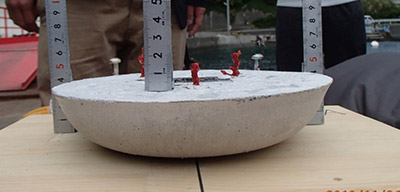
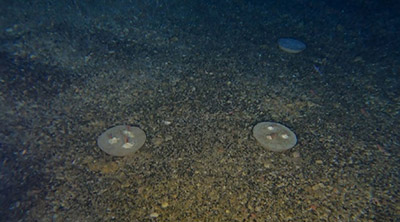 ■ Figure 2: A small disk substrate in which three red coral branch tips are embedded, released from boats to a depth of about 100 m.
■ Figure 2: A small disk substrate in which three red coral branch tips are embedded, released from boats to a depth of about 100 m.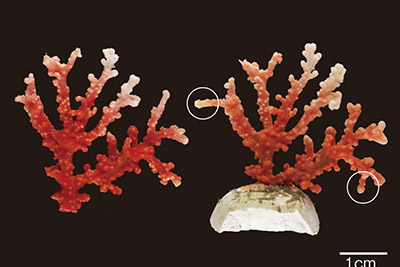 ■ Figure 3: Tips showing growth about one year after being attached to a small piece of fishing reef and released (white circles)
■ Figure 3: Tips showing growth about one year after being attached to a small piece of fishing reef and released (white circles)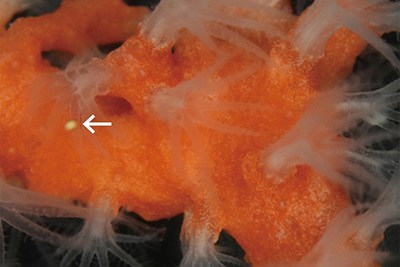 ■Figure 4 Sperm sac (white arrow: yellow sphere) released from the red coral polyp (autozooid)
■Figure 4 Sperm sac (white arrow: yellow sphere) released from the red coral polyp (autozooid)
Outlook for Precious Coral Aquaculture Projects
Precious corals have a very slow rate of growth. It will grow from an initial size of about 1 gram to about 85 grams after 50 years. This estimate assumes that the size at implantation is 50 mm in skeletal axis length and 5 mm in axis diameter and, based on previous research, that it grows into a simple cone shape at 5 mm/year in the direction of the skeletal axis and 0.3 mm/year in the cross-direction. Considering how precious corals branch out into fan shapes, a harvest of precious corals of about 200 grams can be expected in 50 years. On the other hand, this means that managing corals would require the same or a longer time scale than that used in, for example, forestry management.
If the two aforementioned initiatives are combined, and 500 to 1,000 aquaculture substrates continue to be added annually, after 50 years, we could achieve a harvest of more than 100 kg per year, which is equivalent to the amount of live precious corals currently being caught. However, another major issue is whether the industry can wait 50 years.
Precious coral harvests also include coral remains called “kareki.” These remains are utilized commercially, accounting for over half of the trade in precious corals. It has recently been discovered that some of these remains (which make up the majority of the volume of coral in circulation) may actually be a resource that has been accumulated over thousands of years. If this resource is used effectively, it may buy time for the next 50 years to enable artificial propagation projects to be realized. Promoting aquaculture projects as soon as possible is necessary to ensure the sustainable utilization of precious corals. (End)
- 1.Precious Coral Protection and Development Association, https://www.coral-npo.jp/
- 2.Japanese Coral Association, https://www.japan-coral.net/
